
|   |

|   |
In the light of Goddess Durga to the myth of Kali, a concert with a difference - Dr. Nita Vidyarthi e-mail: nitavidyarthi@gmail.com Photos: Tarun Bose January 14, 2024 Diverse strands of unfamiliar thought bound in a common spirit of oneness and understanding woven in the language of Kathak can still be appreciated if the idiom of movement and freshness of expression exudes with a forte for innovation and an awareness of social concerns. A stunning combination of dance, music and visual imagery, the dance-theatre 'Aloye Durga-the myth of Goddess Kali' by Natmandir, Kolkata, spearheaded by the renowned Kathak dancer Anurekha Ghosh, at Gyan Manch, together with an assortment of performances, made for an artfully inspiring and intriguing evening. The offerings that followed were a classical vocal recital by well-known vocalist Koyel Bhattacharya, Kathak performance by the city-based Kathak exponent Sayonee Chavda and her group, Guru Anju Bhattacharya's group of Mogra Nrityangan and a striking solo by Durga Arya, prime disciple of Pandit Birju Maharaj. 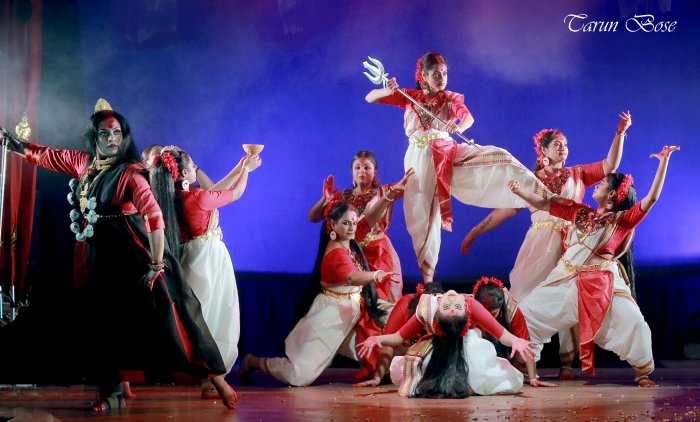 Natmandir After the Pushpanjali to Goddess Adyashakti Mahamaya (primal power-supreme Divine; the Transcendent Mother), the journey from Durga to Kali delved into the beginning - Ravanbadh - when Lord Rama was performing the Akal Bodhan. This is the worship of Devi 'Basanti' (Basanti Puja) in the spring and is the primary worship of Goddess Durga. The now popular one in autumn is the Sharadiya Durga Puja of Devi Sharada. With the refrain of "Ranarangini Elo Oi, Chandi, Chandi, Elo Oi" and the Sanskrit readings from the holy text Sri Sri Chandi, young girls welcome the goddess with a beautiful dance embellished with lovely intertwining formations. This was followed by the theme title song and dance number by seniors of Natmandir. This song "Bajlo tomar alor benu" (The arrival of the Goddess dawns like a ray of light… from a flute) very much a part of the Bengali psyche, is a soothing number ushering in the celebration for the arrival. Well-coordinated harvest dance with sieves (kulo), waving yak tails, dancing with lotus buds in hand in the typical Anurekha's signature style and trying to arouse woman power with energetic dancing, Debojit Mukherjee's fresh choreographic ideas, with new poetics of tradition and an invented vocabulary throughout the whole dance theatre cannot be praised more. "Ya Chandi madhukaito daityo dalani" was a fine piece with all seven dancers in perfect harmony with a fine sense of movement patterns. The wonderment of the light of Durga to that of Kali begins at this point when the dancers with dhunachi (A pot with incense on burning coal or coconut skins) pray to Durga for assertion of her women power - to stop atrocities on women - like the woman who is worshipped on one hand is also burnt alive. Female foetus is killed. 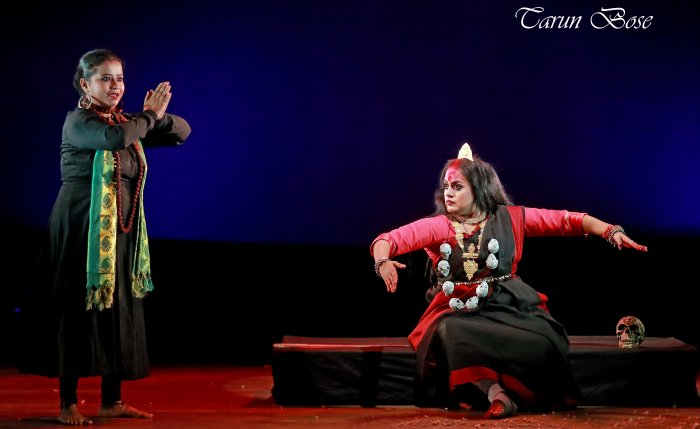 Arunima & Anurekha The narration leading to the central point of the dance theatre - the empowerment of women, to stop violence against them and remove evils - begins at this point. The lighted stage becomes dark, musicians take their positions in corner of the stage. With the soul-stirring strokes of sarod by Sunando Mukherjee, Anurekha Ghosh, dark faced, hair open, vermillion smeared on her forehead, looking a ferocious Kali, walks in slowly with her kharga (a large sickle shaped weapon sharpened at the concave side) in her right hand and a blood-filled human skull in the other, wearing a garland of human skulls, inspecting different directions, encircles the stage and gradually sits on the platform placed in the middle of the stage. Kathak dancer Arunima Sengupta takes her position at the microphone placed at one corner of the stage for padant. The focus shifts from Anandamoyee Durga to the myth of Kali embracing Kali Kawach and Kali Paran from Kalika Puran. The performance moves forward with the kavit: "Tadita tada tada Asura Harani, Kali Kali Mahakali, dhakitataka dha dha kitataka dhetete dhetete jagata Janani Jai Bhabani" recited by Arunima, performed by Anurekha and composed by her Guru Pandit Divyang Vakil. 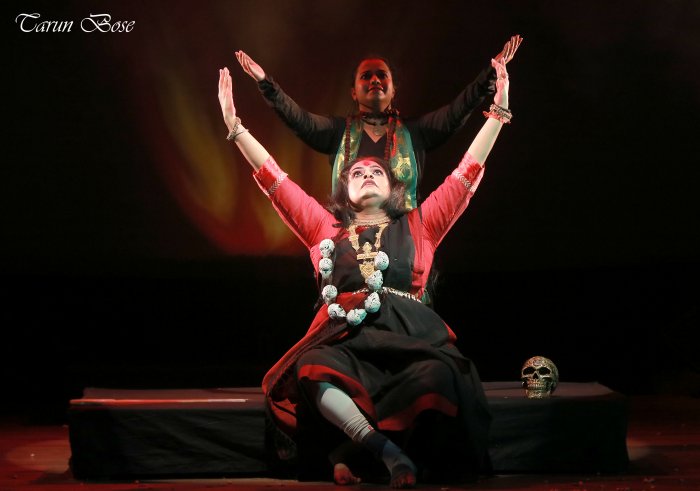 Anurekha Ghosh (bhavabhinaya) Arunima, a consummate dancer, joins in the performance as the woman of modern times raising questions and interacting with Kali - the Mother Goddess being an icon of womanhood - while encircling the stage and breaking into fine chakkars and impactful footwork. Anurekha's quivering hand movements with vigorous encircling, often fierce facial expressions with the strong singing of Koyel Bhattacharya, particularly "Dhaye Kali mahamaya phirey esho" distinctly portrayed the tension that lies between creative and destructive power of the character. The drinking of blood with a lolling tongue projected Anurekha as the fierce Kali, destroyer of ignorance and protector of righteousness – embodiment of Shakti. As the fire of transformation Anurekha as Kali with her spine tingling acting gave some hair raising moments projecting the wrathful aspect of the Divine. Her injured leg which she camouflaged so efficiently and effectively could not stop her from giving her best as a performer or tarnish her baitaki abhinaya or bhavabhinaya as a mature actor. Anurekha sometimes in trance proved herself to be a true artiste. The challenging theatrical imagery was utterly unique and endlessly dynamic, and moved around the often heard "Jayanti Mangala Kali Bhadrakali Kapalini" and the Kali Kawach (armour) beginning with "Dhyayeth Kalim Mahamaayam, Trinettram bahu roopineem" and ending with "Hreem Hreem Hreem Kalika ghore damshtrva rudhira priye". Strong musical accompaniment by the renowned Subir Thakur and Kuntal Das on the tabla, vocal support by Koyel Bhattacharya and the intriguing script by Pokhraj Chakravarty imparted strength to the language of dance. The performers proved how the dance theatre's unusual genesis has made it particularly hard-hitting and relevant in form as well as themes. The other presentations of the concert began with the vocal recital of Koyel Bhattachaya. Koyel trained in the Gwalior gharana and also with Ustad Rashid Khan of the Rampur and Sahaswan gharana offered an impressive rendition of raag Puriya in jhaptaal and teental. In keeping with the theme of the evening she also offered a soulful song "Jaya Jaya Janani Devi". 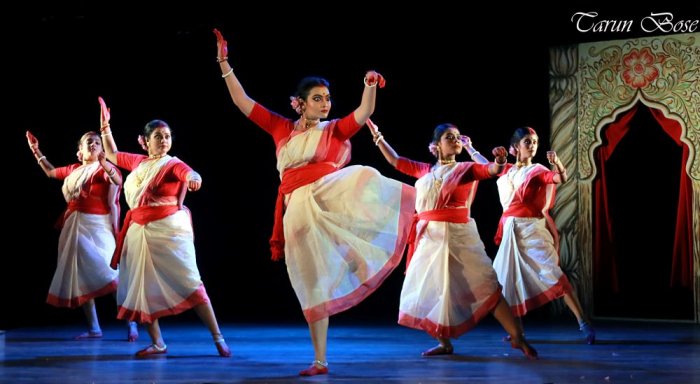 Mogra Nrityangan 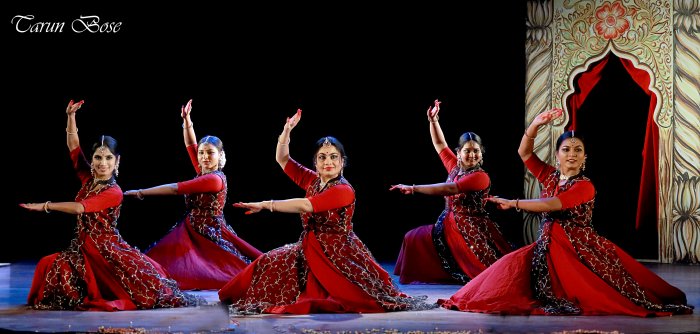 Sayonee Chavda & group Guest artist Sayonee Chavda and her uniformly trained group presented a lyrical and delightfully choreographed "Jayati Jaya bandey Bhavani" that commenced with a short nritta set to the same tune, where the dancers displayed their fine grip on rhythm. The five dancers of Anju Bhattacharya's Mogra Nrityangan featured items with social values like 'Kanya Stuti' and the often heard "Jaya Jaya Jagya Jaye". "Ayi Giri Nandini" was an interesting energetic nritta based item, presented by striking poles on the ground with full bodied physicality. Sculpturesque poses leading to a final frieze of Mahishasura Mardini choreographed by Debojit Mukherjee and Deblina Lahiri was stunning. 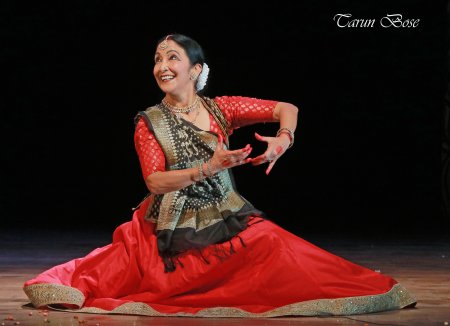 Durga Arya The much awaited solo by the Germany based virtuoso Durga Arya, began with the Vandana "Namoh Namoh Durgey Maharani" depicting Mahalakshmi, the wealth principle and Mahasaraswati, the knowledge principle of Shankarapriya - the Divine Mother. The dancer added grace and not unnecessary energy or power to the piece embellished with tatkaar. And this is her forte, to project the impact without aggression. It is a privilege to watch her offer unique gems of the Lucknow gharana especially nritta, which is actually bhavnritta which adds flavour to her effortless performance. She presented some delightful items "Purana andaz mein" in vilambit with tehzeeb with the tuneful strokes of Sunando Mukherjee's sarod and Subir Thakur's tabla. Thaat and the Upaj retained the individualistic movements thus creating a well-balanced logic of the elements of Kathak with nazakat. Crushing paan (betel leaves) in a mortar and pestle saw her in a coquettish mood whereas moving with a sarpshira hasta (something uncommon) spanning the stage with chakkars saw the fearsome snake in her. Uthan of the "Dha dha dha, purana andaz mein" in different permutations spanning the stage was something to rejoice at. The Durga Stuti "Jaya Janani Mata Bhabani" describing the different images and forms of Durga was of deeply etched intensity and revealed an extraordinary spiritual look of a dancer of high calibre with the final lyrics "Tumhi Parameshwari". Koyel's mellifluous singing added verve to the worthy performance. Every time Durga Arya is on the stage, she comes with a surprise while performing. This time it was a sequence of sawal-jawab with a difference. At the finale, with Koyel's rendition of sargams she responded with a joyous mood, laughing, jumping, sometimes with a staccato rendition of footwork or simply teasing the musicians with her facial expressions. 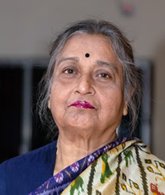 Dr. Nita Vidyarthi is a veteran critic of performing arts and writes on dance, music and theatre in leading publications. |